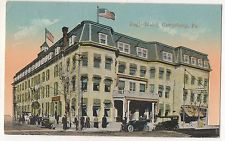0
The Eagle Hotel
For over a century, the Eagle Hotel was a landmark in Gettysburg.
In the mid-1700s a young settler acquired land in an area of Pennsylvania known as Marsh Creek and built a combination home and tavern where two rudimentary roads intersected on the property. Samuel Gettys thus became the father of the hospitality industry in what eventually became a town bearing his name.
James Gettys, Samuel’s son, bought 116 acres of his father’s property in 1785 and platted 210 lots and a town square. Following his father’s precedent, James built his own home/tavern. When Adams County was established in 1800, the younger Gettys successfully lobbied for his community to be named the county seat and leased a room in his tavern to serve as a court room.
Henceforth known as Gettysburg, the borough benefited from its geographical location as settlers streamed west. Its status as a county seat brought locals into town to record deeds, pay taxes, and attend to other legal matters, and the town grew to include many businesses and services. Still, Gettysburg remained a small town with a population of fewer than 2,500 residents in 1860.
It may have been small, but Gettysburg was in no way isolated. Ten roads converged upon it, connecting it to farmsteads in Adams County as well as to other cities. On a map, the town resembled the hub of a wagon wheel from which spokes radiated. In the mid-1800s, railroads ran north to Carlisle and east to Hanover. Thus, many people stopped in Gettysburg, creating the need for a hospitality industry disproportionate to the size of the community.
Between 1800 and 1860 various entrepreneurs established taverns, inns, and hotels to accommodate visitors. One of them, Issac Hahn, received a license to establish a public house at the northeast corner of Chambersburg and Washington Streets in 1805. He sold the facility, which was eventually purchased by James Thompson in 1833. Thompson upgraded the property and named it the Eagle Hotel before selling it to John Tate in 1850.
Tate was running the three-story hotel in 1863 when the Civil War came to Gettysburg. Union General John Buford established his headquarters at the Eagle on June 30, the eve of the battle.
The epic three-day Battle of Gettysburg triggered a flood of visitors into the little town. Newspaper correspondents, photographers, families of the fallen, relic hunters, and the merely curious quickly appeared. A few months later on November 19, fifteen thousand people crowded the town for the dedication of the cemetery designed to honor the Union dead. Abraham Lincoln was among the throng.
Lincoln left, the crowd dispersed, but visitors continued to find their way to Gettysburg. The Eagle and other hotels of the town were there to serve them.
In 1879 Henry Yingling acquired the Eagle Hotel. In 1894 a fire caused severe damage to the structure, but it was rebuilt and sold again in 1896. The new owner, George Eberhart, added a fourth floor, and by 1907 the Eagle boasted 165 rooms.
Many who engaged those rooms were veterans of the battle. Sometimes they came individually for private reasons. Sometimes they came from specific units or states to participate in the dedications of memorials. Other times they came to attend reunions and share memories with their counterparts, both Union and Confederate.
Decades passed and their numbers dwindled, winnowed by death and infirmity, but veterans continued to revisit the field on which they made history. According to a U.S. Army webpage on the Battle of Gettysburg, an amazing 53,407 veterans– 8,750 of them Confederate– attended the battle’s fiftieth anniversary encampment in 1913. Many stayed at the Eagle Hotel, among them General Joshua Lawrence Chamberlain who had helped preserve the Union left flank by ordering the 20th Maine’s bayonet charge at Little Round Top the second day of the battle.

Guests came to the Eagle Hotel by horse and by rail in the nineteenth century, but twentieth-century tourists embraced the automobile.
Whether travelers came for business or personal reasons or to visit the National Battlefield Park established in 1895, the Eagle Hotel continued to host Gettysburg visitors until it was converted into an apartment house in the mid-1900s. In 1960 a second fire destroyed the structure beyond repair. A convenience store now stands where the majestic Eagle once rose four stories high, but the Eagle has not been forgotten. Today visitors can learn the story of the Eagle Hotel, a witness to the bloodiest battle of the Civil War, from a sidewalk marker at the intersection of Chambersburg Street (U. S. 30) and Washington Street.